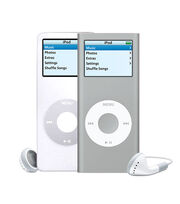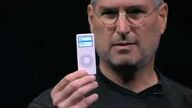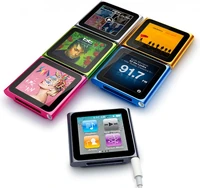The iPod nano is a series of portable media players designed and marketed by Apple Inc. It was the mid-range model in the iPod family. It used flash memory, like the iPod shuffle, but with a 2-inch (2.5 inch on the 7th generation) diagonal QVGA display and the "click wheel" (1g to 5g) found on the iPod classic. The model has been updated six times since its introduction in 2005. Shortly after release, the iPod nano became the highest-selling MP3 player in history, being more successful than its discontinued sibling, the iPod mini.
Features

The 1st and 2nd generation iPod nanos.
Instead of the hard disk used by the original iPod classic, the Nano uses flash memory. This means there are no moving parts, making the iPod nano resistant to hard disk failure due to sudden movement.
The iPod nano works with iTunes on Mac OS X or Microsoft Windows (third-party software is available for platforms that Apple does not support, such as Linux). It connects to the computer via the same proprietary dock connector as all models since the iPod 3rd Generation (with the exception of the iPod Shuffle), using USB 2.0. The current iPod nano does not support syncing over FireWire, but the first three generations can be charged via FireWire. The iPod nano includes a stop watch and a multiple time zone clock function. There is also a combination lock feature that makes use of the click wheel to lock the iPod, and serves to secure the user's calendar and contact information as well as the volume limit function.
Like previous iPod models, the first and second generation iPod nano include some pre-installed games: Brick, Music Quiz, Parachute, and Solitaire. The third generation iPod nano includes pre-installed games, but can also run games which Apple makes available for purchase in the iTunes Store. The three pre-installed games are variations on the Brick, Solitaire, and Music Quiz games found in the first and second-generation iPod nanos. Brick is now called Vortex and there is now a circular playing field. Solitaire is now called Klondike with minimal differences. Music Quiz now includes Movie and TV Show trivia along with a more aesthetically pleasing look. The fourth generation also includes Maze, which uses that model's accelerometer to move a ball around to try and collect glowing orbs by tilting the iPod.
Unlike the preceding iPod Mini, its battery is soldered to the printed circuit board of the device, making it harder to replace manually, although replacement batteries are readily available. The flash memory chips used are surface mount devices, making any attempt to upgrade the Nano's storage capacity impractical.
The lack of the remote connector found on the top of many previous models means that a number of third-party accessories do not work with the iPod nano; newer versions using the dock connector have been made. The first generation iPod nano did not support voice recording; the second and third generation Nanos function with third-party recording attachments. It did not function with either Apple's iPod Camera Connector or other camera connectors from third-party manufacturers.
History
1st generation

Apple Music Special Event 2005 - The iPod Nano Introduction
Made to be the successor of the iPod Mini, Apple introduced the iPod nano at a media event on September 7, 2005. At the beginning of the event, Steve Jobs pointed at his watch pocket from his pants and asked the audience: "Ever wondered what this pocket was for?" describing the size of the iPod nano. The screen on the original Nano was only 1.8 inches but the stated battery life lasted up to 14 hours.
| Picture | Capacity | Battery life | RAM | Colors | Release date |
|---|---|---|---|---|---|
| 1 GB 2 GB 4 GB |
Audio: 14 Slideshow: 4 |
32 MB | White Black |
1 GB: Feb. 7, 2006 2 GB and 4 GB: Sep. 7, 2005 |
Battery risk
In around November 2011 Apple.inc announced that the iPod nano 1st Generation had a battery issue, where small and metallic particles were accidentally introduced in the battery, which might make it overheat or explode without overheating, this was announced due to the increment of accidents with the music player over the years. iPod nano 1g users can actually report their unit and recieve a free replacement, users can recieve an iPod nano 7g with 16gb in silver color.
2nd generation

The iPod nano 2nd generation was available in different colors.
The next iPod nano was released on September 12, 2006 a year later than it's older brother. The new iPod nano looked a lot like the iPod Mini line. It was available in several different colors, (Silver, Green, Pink, Blue, and Black) but unlike the second generation iPod Mini and the first generation iPod nano, the click wheel is gray on the iPod nano second generation except for the black edition. Improvements are that the screen size is bigger, and the battery life grew from 14 hours, to 24 hours.
On October 13, 2006 Apple announced a new (PRODUCT)RED iPod nano with 4GB of storage. Anyone who buys the red iPod nano in the United States, Apple will donate $10. On November 3, 2006 Apple released the 8GB red iPod nano due to popular demand.
| Picture | Capacity | Battery life | RAM | Colors | Release date |
|---|---|---|---|---|---|
| |
2 GB 4 GB 8 GB |
Audio: 24 hours Slideshow: 5 hours |
32 MB | 2 GB: Silver 4 GB: Silver, Blue , Green, Pink, (PRODUCT)RED 8 GB: Black, (PRODUCT)RED |
2 GB, 4 GB, 8 GB: Sep. 12, 2006 4 GB (PRODUCT)RED: October. 13, 2006 8 GB (PRODUCT)RED: Nov. 6, 2006 |

The wider and shorter iPod nano 3rd generation
3rd generation
Apple released the third generation of the iPod nano on September 5, 2007. New improvements are a new 2 inch display, a new interface, and a shorter wider design. The pink model iPod was released on January 22, 2008.
| Picture | Capacity | Battery life | RAM | Colors | Release date |
|---|---|---|---|---|---|
| 4 GB 8 GB |
Audio: 24 hours Video: 5 hours |
32 MB | 4 GB: Silver 8 GB: Silver, Light Blue, Light Green, Black, (PRODUCT)RED, Pink |
4 GB, 8 GB: Sep. 5, 2007 8 GB Pink: January. 22, 2008 |
4th Generation
On September 9, 2008 at the Lets Rock Event, Apple released the fourth generation iPod nano. It returned the design of the first and second generation iPod nano slightly and was available in many different colors. Apple claimed that battery life for music playback would last 24 hours while video playback would only last 4 hours unlike the previous generation which lasted 5 hours. The iPod nano also introduced an accelerometer so when you tilted it sideways you could search the cover flow, which had a totally different interface like the iPod touch cover flow. (PRODUCT)RED was only available on Apple's website at the retail store.
| Picture | Capacity | Battery life | RAM | Colors | Release date |
|---|---|---|---|---|---|
| 8 GB 16 GB |
Audio: 24 hours Video: 4 hours |
32 MB | Silver, Black, Purple, Blue, Green, Yellow, Orange, Pink, (PRODUCT)RED |
Sep. 9, 2008 |
5th Generation
On Apple's Lets Rock Event in 2009 a 5th generation iPod nano was introduced. It resembles the previous 4th generation model with a slightly larger screen, glossier case, and a video camera with microphone on the back corner. This was the only click wheel and non-iOS iPod to feature a speaker, microphone, and camera.
| Picture | Capacity | Battery life | RAM | Colors | Release date |
|---|---|---|---|---|---|
| 8 GB 16 |
Audio: 24 hours Video: 5 hours |
32 MB | Silver, Black, Purple, Blue, Green, Yellow, Orange, Pink, (PRODUCT)RED |
Sep. 13, 2009 |
6th generation

The 6th generation iPod nano is square shaped; bearing the look of an iPod Shuffle with a touch screen.
The sixth generation iPod nano features a completely new 1.5" design like the iPod Shuffle except with a 1.4.9" multi touch screen. The new user interface looks more like a simplified version of the popular iOS. The new iPod nano removes the click wheel, video recording and music videos, and some even said that it removes voice recording, but it is revealed that when you plug in the mike accessory a voice memos app will appear. You can sync videos onto the iPod nano and pictures, but it isn't very popular because of the tiny screen. Lastly, the iPod nano 6th gen battery hasn't improved over the 5th gen and there is a small clip so you can listen to music while you are jogging or at the gym. Some users replaced the clip with wrist bands to use it as watch-like device before the introduction of the Apple Watch.
| Picture | Capacity | Battery life | RAM | Colors | Release date |
|---|---|---|---|---|---|
| 8 GB 16 GB |
Audio: 24 hours | 64 MB | Silver, Graphite, Blue, Green, Orange, Pink, (PRODUCT)RED |
Sep. 1, 2010 |
The 7th generation iPod nano features a iPhone/iPod nano 2g hybrid design
7th generation
The seventh generation iPod nano was announced on September 12, 2012. It features a 2.5 inch screen and multitouch gestures. It has a iPhone/iPod nano 2g Hybrid shape, the icons are based in iOS icons, except that they are now circle shaped. It also features the new Lightning connector.
| Picture | Capacity | Battery life | RAM | Colors | Release date |
|---|---|---|---|---|---|
| 8 GB 16 GB |
Audio: 24 hours Video: 3.5 hours |
64 MB | Slate, Silver, Pink, Yellow, Green, Blue, Purple, (PRODUCT)RED |
October. 12, 2012 |
Reception
The initial consumer response to the iPod nano was overwhelmingly positive and sales were heavy.[1] The Nano sold its first million units in only 17 days, helping Apple Inc. to a record billion-dollar profit in 2005.[2]
Apple's release of the iPod Nano as a replacement for the iPod Mini was viewed by many as a risky move.[3] Steve Jobs argued that the iPod nano was a necessary risk since competitors were beginning to catch up to the iPod Mini in terms of design and features, and believed the iPod nano would prove to be even more popular and successful than the iPod mini.
Within days of the Nano's release, some users reported damage to the Nano, suggesting that the LCD screen had become so scratched that it was unreadable, even when the backlight was on. Many reported fine scratches on Nanos, caused by microfiber cloths. Other owners reported that their Nano's screen cracked without use of excessive force.[4] On September 27, 2005, Apple confirmed that a small percentage ("less than 1/10 of 1 percent") of iPod nanos shipped with a faulty screen and agreed to replace any that had cracked screens, but denied the iPod nano was more susceptible to scratching than prior iPods.[5] Apple started shipping iPod nanos with a protective sleeve to protect them from scratches. In October 2005 a class action lawsuit was filed against Apple, with the plaintiffs seeking reimbursement for the device, legal fees, and "unlawful or illegal profits" from sales of the iPod nano. Lawyers for the plaintiffs claimed that the devices "scratch excessively during normal usage, rendering the screen on the Nanos unreadable, and violating state consumer protection statutes".[6] Similar lawsuits were later filed in Mexico and the United Kingdom.[7] In early 2009, Apple was in the process of settling a court case over the scratched iPod nano screens. It was suggested that Apple should set aside $22 million to refund users. At the time, it required a Judge's sign-off on the terms by April 28, 2009.[8] Some commentators such as BusinessWeek's Arik Hesseldahl have criticized the lawsuits. Hesseldahl dismissed them as "stupid" and suggested that they benefitted "no one but the trial lawyers," but also suggested that Apple could have avoided litigation by offering "full refunds on unwanted Nanos" instead of charging a re-stocking fee and lengthening the return period from 14 days (when purchased through Apple retail or online) to 30 or 60 days.[9][10]
References
- ↑ Michelle Myers (September 10, 2005). Apple store buzzes with Nano fever. CNet. Archived from the original on January 11, 2006. Retrieved on September 15, 2005.
- ↑ Daniel Drew Turner (October 11, 2005). Apple Hits $1 billion in Profit for 2005. eWeek. Retrieved on January 3, 2006.
- ↑ Burrows, Peter (September 13, 2005). iPod nano: Will small size mean big sales?. BusinessWeek. Archived from the original on September 14, 2007.
- ↑ Angell, Larry (September 25, 2005). iPod nano screen complaints abound. iLounge. Retrieved on September 27, 2005.
- ↑ Jim Dalrymple (September 27, 2005). Apple responds to iPod Nano screen concerns. Macworld. Retrieved on September 28, 2005.
- ↑ Kasper Jade; Katie Marshal (October 21, 2005). iPod Nano owners sue Apple over screen issues. AppleInsider. Retrieved on October 21, 2005.
- ↑ "Nano lawsuit goes international", BBC News, November 8, 2005. Retrieved on May 10, 2006.
- ↑ Apple Settles iPod Nano Scratch Lawsuit with $25 Refund. Macrumors.com (January 23, 2009). Retrieved on November 29, 2011.
- ↑ Hesseldahl, Arik (October 27, 2005). iPod nano Lawsuits: Who Wins?. BusinessWeek. Archived from the original on October 29, 2005. Retrieved on November 8, 2005.
- ↑ Libgpod - gtkpod iPod Manager. Gtkpod.org (2011-10-15). Retrieved on 2012-11-17.
External links
- iPod nano (7th generation) at Apple (archived 2012-09-13, 2017-07-26)
- iPod nano (6th generation) (archived 2010-09-07, 2011-10-06)
- iPod nano (1st generation) (archived 2005-10-01)
- Identify your iPod model: iPod nano
- Tech Specs: iPod nano
- iPod Nano at Wikipedia

